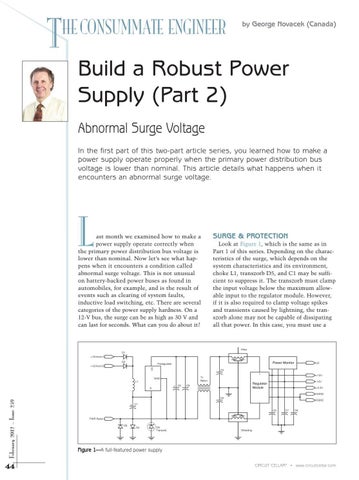T
HE CONSUMMATE ENGINEER
by George Novacek (Canada)
Build a Robust Power Supply (Part 2) Abnormal Surge Voltage In the first part of this two-part article series, you learned how to make a power supply operate properly when the primary power distribution bus voltage is lower than nominal. This article details what happens when it encounters an abnormal surge voltage.
L
February 2012 – Issue 259
ast month we examined how to make a power supply operate correctly when the primary power distribution bus voltage is lower than nominal. Now let’s see what happens when it encounters a condition called abnormal surge voltage. This is not unusual on battery-backed power buses as found in automobiles, for example, and is the result of events such as clearing of system faults, inductive load switching, etc. There are several categories of the power supply hardness. On a 12-V bus, the surge can be as high as 30 V and can last for seconds. What can you do about it?
44
SURGE & PROTECTION Look at Figure 1, which is the same as in Part 1 of this series. Depending on the characteristics of the surge, which depends on the system characteristics and its environment, choke L1, transzorb D5, and C1 may be sufficient to suppress it. The transzorb must clamp the input voltage below the maximum allowable input to the regulator module. However, if it is also required to clamp voltage spikes and transients caused by lightning, the transzorb alone may not be capable of dissipating all that power. In this case, you must use a
Figure 1—A full-featured power supply CIRCUIT CELLAR®
•
www.circuitcellar.com





